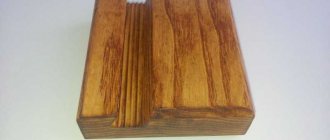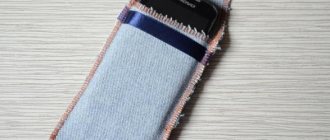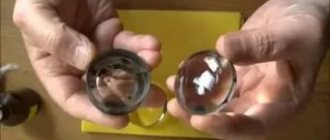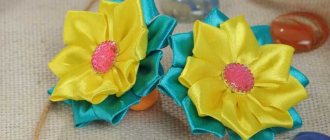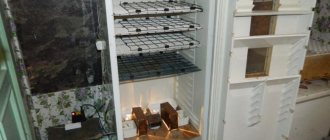Every owner has in their hands not only a phone, but also the ability to protect its display from damage. The solution is very simple - you just need to stick a protective film. You can do this yourself, at home, in 5 minutes.
The display is the most vulnerable point of modern smartphones. The appearance of scratches or cracks, scuffs and chips is what can happen to the device screen. Not all manufacturers install tempered glass in their phones. This is what prevents scuffs and minor scratches from appearing on the display.
How to replace protective glass
Prepare a new replacement glass and a wet and dry cloth to remove traces of the previous glass. Usually the necessary wipes come with a new protective coating. If wipes are not available, use a regular alcohol wipe or a cotton swab soaked in alcohol.
You will also need a wooden toothpick or a wooden match sharpened at one end to pry and remove the old glass. You will also need a dry cloth to squeeze out air, stickers to remove dust particles, or tape with stationery scissors. Before replacing glass, wash your hands to degrease or use rubber gloves.
Instructions:
Place your mobile device on a flat surface. It is advisable to place a towel or other non-slip fabric.
Use a toothpick or match to pry off the protective glass. The best place is in a corner or where the glass has peeled off. Next, with light movements to the left and right, move along the glass to gradually separate the silicone base, which is used to fasten the glass.
To prevent the glass from accidentally sticking back, place a plastic card in the place where you managed to separate the glass. Do not apply excessive force when holding the glass tightly, otherwise the glass may break or crack.
After two years of use, it is often impossible to remove old glass without damaging the glass itself. In this case, you should stick stationery tape over the glass and continue to slowly remove the glass.
Once the silicone has loosened sufficiently, remove the glass.
Wipe the screen module with a damp cloth No. 1 to remove the previous silicone coating and dust. Use a dry cloth No. 2 to remove any remaining moisture and remaining stains.
Clean your smartphone glass.
Remove any remaining moisture.
Before installation, attach the glass to the screen module for fitting.
Remove shipping film No. 1 from the new glass.
Place the edge of the new glass against the screen module, and then gradually release the glass, simultaneously squeezing out the air with a dry cloth.
If there is air or dust particles trapped under the glass, remove the glass using a wooden toothpick or match. Smooth the glass again to remove air. Use Guide Stickers or office tape to remove dust particles.
After successful installation, remove shipping film No. 2.
Alternative solutions to the problem
The fact that it is not possible to carefully cut protective glass at home does not mean that you will have to be left without a protective accessory. We offer several options to solve this problem.
Selecting protective glass from another model
In order to select such a protective glass. You will have to spend a lot of time in the accessory store, and if you are ready for this, then first you need to select a list of smartphone models with the same screen diagonal and aspect ratio. At the same time, it is also worth considering the placement of the earpiece (whether a cutout is needed for it), after which, with a huge list, you need to go to the store where you can apply protective glasses and weed out the unsuitable ones.
Read also: How to use a torque wrench with a ratchet
It is also worth clarifying that the likelihood that the cutout for the proximity and lighting sensors will coincide with their locations on your smartphone is close to zero, which means that they will not work under a layer of glass.
In this same block we will also include fittings of universal glasses from different manufacturers, since with the same diagonal, different manufacturers make glass with different heights and widths. In this case, you can look at these indicators in the glass characteristics in the online store.
Trimming the universal protective film
If you cannot cut the protective glass at home, then with the film things are different, but you should follow some recommendations so as not to damage the adhesive layer.
You can cut not only universal film, but also any other film.
To do this, place it on the smartphone screen with the side marked 1 down, trace the contours, but do not mark small holes, you will not be able to cut them out so as not to damage the silicone layer, instead of several small cutouts, it is better to make one common one for them.
Place the film on a hard work surface and cut with a sharp utility knife or scalpel in one motion. Do not use scissors, they will bend the edge and it will not stick in this place.
Next, you can glue the film to the device screen, having previously treated it from grease and dust with the wipes included with the film.
The protective film is not as hard as glass, but in most cases it is enough to protect the screen from scratches and abrasions.
Is it possible to do without glass at all? Yes, use a book case
Although this option is not the most reliable, most of the time the smartphone in such a case is closed and the likelihood of damage to the screen is minimal. And if you combine the protective film with a book case, you can keep your screen in excellent condition throughout the entire period of use.
Read also: Alexander Shenrock speed control with power maintenance
And as a nice bonus, we offer readers of this article a 10% discount on protective accessories in the online store Floy.com.ua
To do this, use the promotional code art10 when placing an order, and the order amount will be reduced by 10% .
How to replace the protective film
The principle of replacing protective film is similar to glass. It is advisable to prepare 2 films, since due to difficulties in installation, it is not always possible to stick the film the first time. You also need a dry cloth to squeeze out air, stickers or tape with office scissors to remove dust particles, a wooden toothpick or a sharpened match.
Instructions:
Use a wooden toothpick or match to pry it off and then remove the film.
Wipe the coating with a damp cloth No. 1 to remove any remaining silicone coating and dust. Use dry cloth No. 2 to wipe away any remaining moisture and remaining stains.
Try on the film, then remove shipping cover No. 1.
Place the edge of the protective film on the screen of your mobile device.
Use a dry cloth to squeeze out the air trapped under the film and gradually continue further installation of the protective coating.
If there is any remaining air or dust particles, remove the film to remove air or dust particles.
If installation is successful, remove shipping cover No. 2 from the film.
How to cut glass without a glass cutter
Tools for cutting glass were not always as widespread as they are today.
In the second half of the last century, people came up with their own ways to conquer this capricious material, without using a glass cutter. In fact, to cut non-tempered glass up to 8 mm thick, you can use many available items, you just need to have a little skill. It is better to start listing items suitable for working with glass by identifying the types of impact on this material. The main methods include thermal, when glass is heated in a certain place, and physical, when it is cut by brute force. The industry uses a waterjet cutting method, when glass is processed using expensive equipment under strong water pressure.
To cut glass using the thermal method, all you need is a small piece of string and a flammable liquid like alcohol or acetone; a soldering iron and a burning apparatus can also be used as a cutter. To cut glass by physical force, you can use a file, a pobedit drill, a nail, a thin diamond disk, and even ordinary tailor's scissors. Of course, some of the listed items are difficult to get a good chip, but with the right skill, a quite suitable result can come out. Now, knowing how you can cut glass without a glass cutter, you can move on to the process itself.
So is it possible to cut glass after tempering?
In fact, tempered glass can be cut. But you need to properly prepare for this so as not to end up turning a whole sheet into a mass of parts with blunt edges. To destroy a sheet, it is enough to simply hit its end with any suitable object. To change the size of the product, create cutouts, etc., you need to adhere to the technology and, first of all, directly study the properties of tempered glass.
Example 1. Tempered glass cutting technology.
The manufacturing technology of tempered glass is such that during its production, zones called internal stress areas are formed. When heated and further sharply cooled, the stress zones are redistributed. As a result of such changes, the inner layers retain the characteristics of a liquid body, remaining viscous, and the outer layers become much more durable when compared with simple glass that has not undergone the tempering procedure.
When point blows are applied to the end zones, another redistribution of the existing stresses occurs. Due to microcracks, the integrity of the sheet is compromised, so that if handled incorrectly, even the slightest blow will lead to the formation of extensive webs of cracks of various sizes. The glass will simply collapse at the slightest external force. This principle is the basis for car windows: they can be easily broken by a sharp blow from a sharp object. The film makes the glass injury-proof: it holds the fragments and does not allow them to harm the driver.
Thus, tempered glass receives its special properties directly during the tempering process. According to the technology, the material is first cut into the required pieces, holes are made, the shape is set, and after that it is hardened. Experts recommend refraining from further mechanical processing. However, if you are serious and categorical, first prepare your tools and remember the important nuances of cutting tempered glass.
Step-by-step instructions for cutting tempered glass
Cutting tempered glass involves preliminary annealing of this material. The process involves heating tempered glass evenly. The main task of this stage is to eliminate the stresses that appeared in the material during the previously performed hardening. It is these stresses that are the main obstacle to cutting safety glass. Get rid of them and you will be able to realize what you planned.
Annealing is performed in the following order. First, the glass is soaked in water at a constant temperature. It is necessary to soak until the temperature corresponding to the viscosity in the furnace unit is reached. It is equal to η = 1013 Poise. The time it takes to soak depends on how large a piece of glass you are cutting.
Example 2. Tempered glass cutting technology.
Glass brands Bullseye, Effetre and Lauscha are soaked at a temperature of +504 degrees Celsius. Borosilicate glass requires a higher soaking temperature, +566 degrees. And for Satake brand glass, the optimal temperature is +477 degrees. It takes an average of 20 minutes to soak small beads. Larger beads should be kept for an hour. Large paperweights are aged for 12 hours or more. Especially large products weighing 40 kg or more in some situations require hardening for a period of several months.
The glass must be gradually cooled to a temperature below the deformation temperature. It is equal to η = 1014.5 Poise. The process should be done fairly slowly so that additional stress does not occur. Satake brand glass is cooled at a temperature of +399 degrees Celsius. For cooling products of other brands, a temperature of +427 degrees is suitable. The glass must be cooled in the oven to room temperature.
Put on your safety glasses and start cutting the annealed glass. Take a square and mark the cutting line. The square must be held along the left line. Cut along the line with a glass cutter. Press with medium force, making a scratch along the marking line. It is allowed to carry out only 1 time along the line.
Next, you need to take a wooden rod 6mm in diameter, place it under the cutting line and apply a quick and sharp pressing force on both sides. If done correctly, the glass will break into 2 neat pieces. The edges of the resulting parts must be processed using a grinding stone. This will make the product more durable and safe.
If desired, the glass can be re-tempered. It is better if a professional does this work. The procedure requires appropriate skills and special equipment, so a beginner simply cannot cope with it.
Since the process of cutting tempered glass, which in practice is cutting annealed glass, is multi-step, you can simplify the task by purchasing plain glass, cutting off the desired sections from it, or preparing the desired holes and tempering it. This will save money, effort and time.
The list of necessary tools and devices mentioned a thermostat. It is needed to maintain the temperature in the oven at a constant level. You can do without it, but it’s easier with it.
Therefore, cutting tempered glass is very difficult. If you do not want to spoil the finished product, it is better to order new tempered glass or cut regular material and then either temper it or order it. Good luck!
Cutting tempered glass at home
Tempered glass is considered one of the most common materials. To increase its strength, hardening technology is used. After carrying out such a procedure, the degree of machinability of the material is significantly reduced. When considering whether it is possible to cut tempered glass, we note that only by using special technologies can the occurrence of a defect be avoided. Today, cutting tempered glass can be done at home, using a variety of tools.
Features of stickers for some models
The main feature of each individual product will be the size of the glass and the presence of holes for function keys. As an example, it would be relevant to study the features that protection for an iPhone has, for example, a product such as Zool iPhone 5 0.1mm 9H.
Such pieces of glass have such features as an exact match to the size of the smartphone, the presence of a special coating for comfortable operation of the device, and increased protective properties of the glass combined with an ultra-thin design. However, as with other products, it is unlikely to be possible to remove the glass and put it back in place a second time.
Remember that you are putting a screen protector on your iPhone for security, not aesthetics or functionality. Carefully match all edges and holes before placing the glass screen on the device.
Can tempered glass be cut? — Machine tools, welding, metalworking
Glass cutting is carried out mainly in production, but sometimes such a need arises at home. Of course, it is very good if a person has cut glass at least once in his life, but what should those who have no idea how to cut tempered glass do?
To cut glass, you need to purchase a glass cutter; it looks very similar to a can opener. In production, they use special, equipped tables for cutting tempered glass, and in domestic conditions, you can use an ordinary dining table, having previously covered it with a thin cloth.
Why do you need glass?
Previously, the smartphone screen was covered with film to protect it from cracks. Over time, dust accumulated under the edges of the film, which scratched the display and spoiled the appearance of the device. Also, the film often worsened color reproduction and slowed down the sensor's response to clicks. The film was replaced by tempered glass, which:
- reliably absorbs shock - if dropped hard, it will crack, leaving the display intact;
- scratch-resistant - even if you carry your phone in the same pocket as your keys, there will be no traces of contact;
- holds tightly over the entire surface.
The disadvantages include the thickness - after applying the sticker, the smartphone will become 0.2-0.5 mm wider. Also, good glass is not cheap, but it is still several times cheaper than replacing a broken screen.
A plastic card
Do not pry the protective glass with your fingernail or especially with a knife blade. At best, you won't succeed, and at worst, you'll ruin your phone's display. Pry the protection with an old bank card in one corner and run the plastic around the entire perimeter, gradually moving towards the center. If the card is too thick, you can sharpen it with a nail file or a needle file.
Plastic cards are good because they are large enough to remove the entire width of the protective glass. In another case, due to point impact, there is a risk that the protection will crack and scratch the screen. Always choose the most intact corner so as not to accidentally push small fragments deep into the corner.
Photo: geekometr.ru
How to get rid of odor in shoes: 10 simple ways
What are there
Glass is made for specific models to fit the screen size. There are also universal ones, but they may not guarantee one hundred percent surface protection. Before you figure out how to glue glass, let's look at what they are and what to consider when choosing. Types of glass:
- Flat 2D. Completely covers the surface;
- 2.5D with a colored frame to make the image look more natural. Completely covers the surface and curved edges of the screen;
- 3D. Repeats the shape of the curved edges of the body;
- UV glass. General name for glass with ultraviolet hardener. The glue is applied to the display, the glass is placed on top. The glue hardens thanks to the ultraviolet lamp included in the kit.
Coating:
- Oleophobic. Fingerprints are not visible on it. They are easy to remove;
- Matte. Helps avoid glare. Convenient to use in the sun.
Strength
Measured on the Mohs scale. The surface was scratched with the hardest minerals existing on the planet. When a trace remained, a serial number was recorded. Choose the 9H indicator. The surface was scratched by a diamond. It is difficult to damage such glass.
Thickness
The values are in the range of 0.1-1 millimeters.
Thick glass may reduce the sensitivity of the screen's touchscreen. Choose the average - 0.3-0.33 millimeters.
Adhesive base
On flat glass, manufacturers apply glue to the entire surface. On glass with a colored frame and 3D - only on the frame. Therefore, air spots may form in the middle. They are used without any additional glue purchased.


